If a video could appear only by typing a sentence, would you take advantage of it? Thanks to their most recent artificial intelligence development, Facebook, Instagram, and WhatsApp parent company Meta is making it a reality. The revolutionary application opens up a world of possibilities for content creation and storytelling by enabling users to make high-quality films from simple text suggestions.
Think of all the things that could be made: a funny cartoon of a talking cat, a dramatic scene from history, or a touching collection of family memories. How we make and consume material could change because of this technology, but what are the moral implications of such powerful tools? Does someone want to use them for good or bad?
New Meta Video-Generating Model is Game-Changing
Meta has created a video generation model that leverages highly advanced algorithms of artificial intelligence to generate videos all alone with minimal human input. The technical capability in this device enables it to expand short video snippets, still photographs, or even textual descriptions into longer, more elaborate videos. This concept revolutionizes the way content creators, marketers, and developers make videos since it is easier and faster with less human participation.
This model, with its unparalleled ability to render videos very convincingly, is capable of making seamless transitions with logical story lines. Meta's model is able to grasp and recreate visual information with incredible accuracy through its use of GANs and other deep learning methods. It's a highly infancy-tool that may potentially turn things upside down in video-centric industries like e-commerce, social media, advertising, and entertainment.
Functions and Applications
There is incredible potential for Meta's video generation mechanism across the entire broad spectrum of sectors and use cases. The content development business will be the largest beneficiary because video now dominates all of the online communication that goes on. All these websites, blogs, and social media rely on visual narrative, and Meta's AI approach could let producers provide more material much faster and cheaper.
This technology also is going to positively affect advertising. The idea will easily allow brands and enterprises to execute targeted campaigns by creating video commercials that can be fit for specific demographics and markets.
Among the other applications of Meta's AI for entertainment are producing previews of games or movies that should be coming out, and even scenes from scripts to help ease the process of film production. Also, classic video games feature cutscenes, which are cinematic moments that either progress the plot or provide dramatic touches. To make things easier, Meta's video-generating model can take narrative input or in-game events and use them to generate realistic cutscenes for use in the game. Freeing up resources to concentrate on fundamental gameplay features, developers have the ability to automate the generation of dynamic, story-driven scenes.
Take your favorite real money slot game as an example. What if they could create animations in real time depending on factors like a player's winnings, gameplay style, or even the amount of time spent playing? Just in case this happens, stay up-to-date on the newest news regarding online casinos and look for a website that provides enough information. This would make the game feel more real, which would make gamers stay for more time. Each gaming session could feel distinct thanks to AI-driven visual upgrades that adapt themes and settings for diverse user preferences.
Methods That Underpin Meta's AI System
Meta's advanced AI movie creator uses many AI algorithms. Central to it is the Generative Adversarial Network (GAN), a framework for machine learning that utilizes the cooperation of two neural networks. A discriminator network determines how realistic video sequences are, while a generator network produces them. The generator iteratively improves its output in response to the discriminator's evaluations, creating a feedback loop that allows for progressively lifelike films that are often hard to tell apart from human-made content.
The model uses state-of-the-art computer vision techniques to accomplish such a degree of realism. The AI learns to identify and reproduce patterns, textures, motions, and lighting circumstances by studying massive databases of pictures and movies. Because of this, it can make movies that look like they were shot in real life. The ability to comprehend written descriptions and convert them into visually equivalent content is another critical function of natural language processing. The user need only submit a textual instruction, and the AI will produce a movie that faithfully conveys the desired message.
The AI model's architecture showcases Meta's commitment to scalability and efficiency. This technology is perfect for corporations and enterprises that need content produced quickly because it can manage large-scale projects efficiently and with few resources.

















